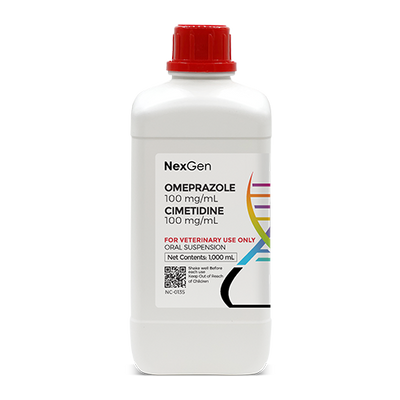
Omeprazole 220 mg/mL + Cimetidine 100 mg/mL, Oral Paste, 30mL Syringe
Login for pricing
- Brand
- Mixlab
- SKU:
- NC-0133
- Product Type:
- Paste
- Size:
- 30ml
- Administration:
- Oral
Gastric ulcers in horses (Equine Gastric Ulcer Syndrome or EGUS) are caused by prolonged exposure of the gastric mucosa to gastric acids which can result in ulceration and bleeding. EGUS is most closely associated with performance horses, horses that have been stressed over a protracted period of time, and horses with underlying comorbidities. Its prevalence in unmedicated racehorses in active training is at least 90%, whereas in non-racing performance disciplines, its prevalence is over 60%.1 Foals are known to be at high risk for the development of perforating peptic ulcers until they are several weeks old due to the undeveloped state of their gastric mucosa. Spontaneous remissions of these lesions have occasionally been described, but horses that remain in situations tending to give rise to this malady are likely to remain compromised without medical intervention.
A horse’s stomach essentially has two sections: An upper non-glandular region where food enters the stomach, and a lower glandular region where hydrochloric acid (HCl) is produced. While the lower region is constantly exposed to gastric acids, it generally has adequate protection from these acids; as a result, lesions are most commonly found in the upper region.
Horse’s stomachs are smaller in comparison to other species of similar size, and in the wild, they eat periodically throughout the day through grazing. Consequently, the feeding regimens demanded by owners, managers and trainers tend to run counter to the horse’s natural biological processes. Stress is also believed to be a major contributor to EGUS. Transportation, stall confinement and the rigors of performance (where performance horses are involved) are all additional risk factors for EGUS.2 Finally, the repeated administration of nonsteroidal anti-inflammatory drugs (NSAIDs) can impede the production of mucus in the stomach, making the horse far more susceptible to ulcers.
Clinical Signs of Gastric Ulcers in the Horse:
Many horses suffering from EGUS do not exhibit clinical signs, but subtler signs of EGUS can include:
- Poor appetite
- Weight loss
- Dullness
- Changes in mood and/or behavior
- Decreased performance
- Reluctance to train
- Poor body condition
- Dull coat
- Colic
Horses with more serious cases of EGUS may experience abdominal pain and/or display grinding of the teeth.1,2Occasionally, a horse with advanced ulcerative disease may be found on its back. This is more common with foals, and it is believed that this position provides relief from the pain associated with acidic fluids bathing sensitive parts of the stomach. Some horses will walk away from food if they experience discomfort with the first mouthful.1
In foals, the clinical signs of ulcerative disease include intermittent colic, frequent recumbency, reduced nursing, diarrhea, poor appetite, a pot-bellied appearance, grinding of teeth, and excess salivation.1,3 If a foal exhibits clinical signs, the ulcers are likely to be severe and should be diagnosed and treated immediately.
Diagnosis and Treatment of Gastric Ulcers
Gastric ulcers may be diagnosed most accurately via gastric endoscopy (gastroscopy), although the veterinarian may make a tentative diagnosis based on clinical signs and how the horse responds to therapy.
Suppression of gastric acidity and maintenance of a pH between 4 and 5 are the primary treatment objectives in mitigation of EGUS in the horse.4 Historically, antacids not been proven to be effective in either healing or preventing gastric ulcers, and they must be administered in relatively high volumes every two hours to neutralize stomach acid.
Omeprazole is a proton pump inhibitor that is often used to treat GI ulcers and erosions.3 Omeprazole is useful in the treatment of both gastroduodenal ulcer disease and prevention or treatment of gastric erosions caused by ulcerogenic drugs (eg, aspirin, NSAIDs).
Omeprazole is available in liquid, paste and powder formulations that have been very effective in preventing and treating gastric ulceration in all types of horses. For the treatment of gastric ulcers in horses, the recommended dosage of omeprazole is 4 mg/kg PO every 24 hours for 4 weeks. To prevent recurrence of ulcers, the dosage is 2 mg/kg PO every 24 hours for at least another 4 weeks. Doses as low as 1 mg/kg PO once daily were effective in treating squamous ulceration when administered following a brief fast and prior to exercise.4
Cimetidine competitively inhibits histamine at the H2 receptors of the parietal cells, thereby reducing gastric acid output both during basal conditions and when stimulated by food, pentagastrin, histamine, or insulin.3 Gastric emptying time, pancreatic or biliary secretion, and lower esophageal pressures are not altered by cimetidine. By decreasing the amount of gastric acid secretions, cimetidine also decreases pepsin secretion. Cimetidine has an apparent immunomodulating effect, as it has been demonstrated to reverse suppressor T-cell-mediated immune suppression. It also possesses weak anti-androgenic activity.6
NOTE: Cimetidine is a CLASS 5 DRUG under the Association of Racing Commissioners International (ARCI) Uniform Classification Guidelines for Foreign Substances (UCGFS).
Where to buy Omeprazole + Cimetidine
Omeprazole + Cimetidine is available in the U.S. through pharmaceutical manufacturers and through veterinary custom compounding companies.
This product carries several potential drug interactions. Please consult your veterinarian prior to beginning any treatment regimen.
FOR RX ONLY: A valid prescription from a licensed veterinarian is required for dispensing this medication.
1Young, A. Equine Gastric Ulcer Syndrome. In: Journal UC Davis School of Veterinary Medicine, July 29, 2019.
2Andrews, F. Gastric Ulcers in Horses. In: Merck Veterinary Manual, Jan. 2014.
3Loving, N. Research on Treatment of Equine Gastric Ulcer Syndrome. In: EquiManagement.com, Jan 13, 2019.
4Merck Veterinary Manual.
6Sykes BW, Sykes KM, Hallowell GD. A comparison of three doses of omeprazole in the treatment of equine gastric ulcer syndrome: a blinded, randomised, dose-response clinical trial. Equine Vet J. 2015;47(3):285-290.











